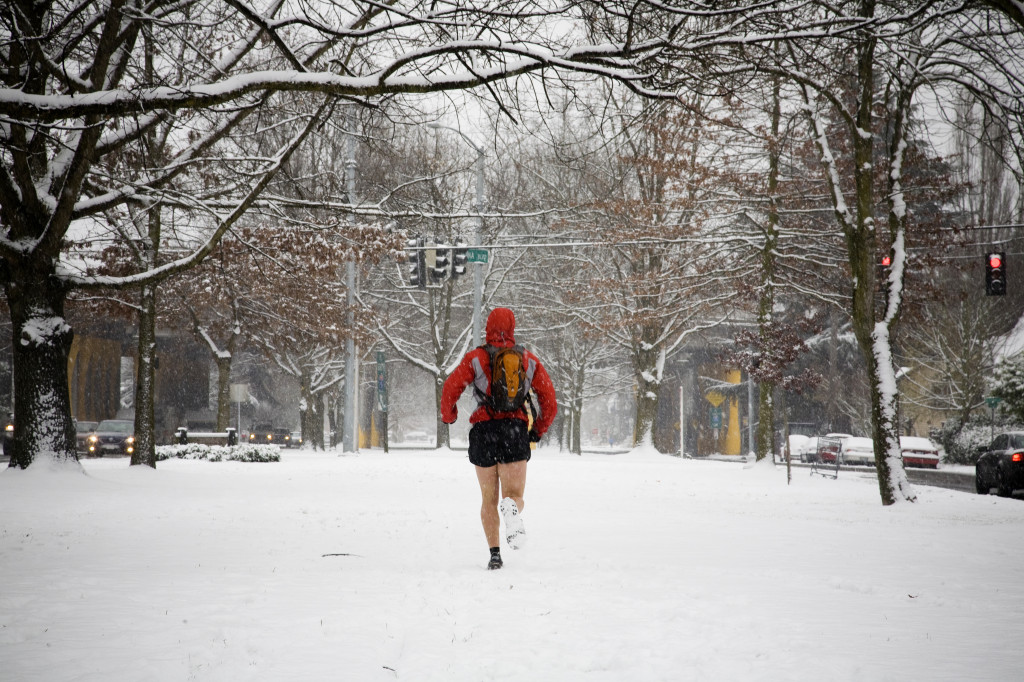Feature: run-commuting – change your life, run to work
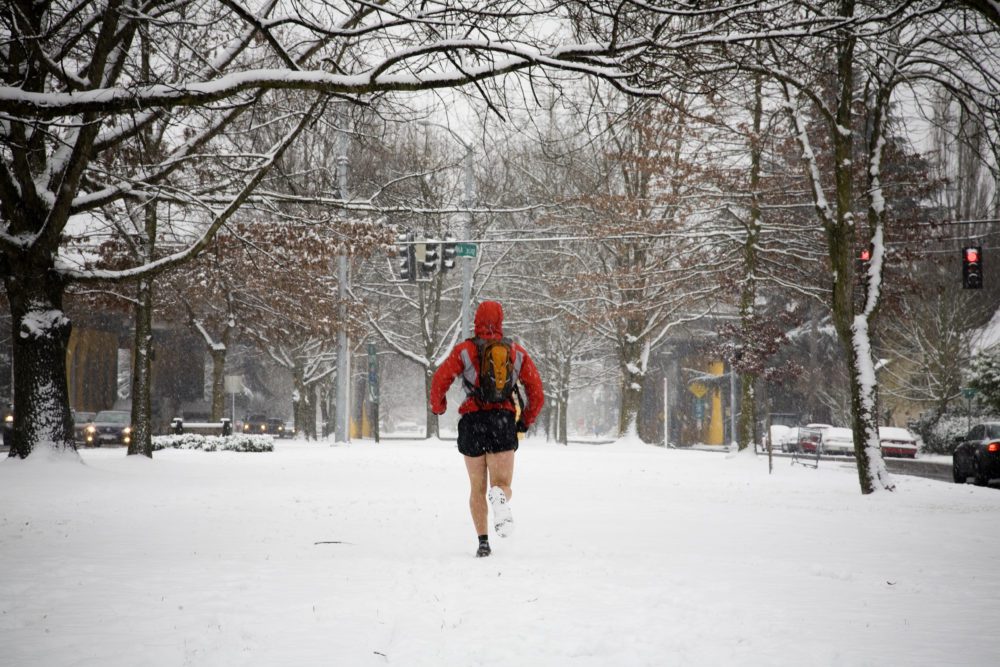
With millions of Canadians stuck in traffic for hours each week, some are opting out and hitting the roads as run-commuters
By Lesley Evans Ogden
The view of the St. Lawrence River is ever–changing. In the depths of winter, there is steam rising, and chunks of ice float by. Stuck in their cars high up on the bridges during rush hour, most people get no such intimate view of the river that surrounds the island of Montreal. Not so for 39 year-old Montrealer Joan Roch. “When I’m running, I’m just a few metres above the river, and I see all these things that very few people can see,” he says. Running along the riverbank, step by step, “I feel much more connected to the river in which Montreal sits. It changes from day to day,” says Roch. He sees this subtle metamorphosis as he runs back and forth to work each day.
Squeezing in time to run during the workday is a constant challenge. But what if running was something we didn’t have to squeeze in? What if it became an essential component of each workday? That’s the shift in thinking that a small but growing number of individuals have embraced by seeing running not only as a recreational pursuit but as a mode of transportation that combines a workout with getting from point A to point B.
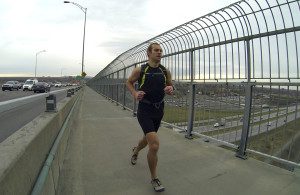 Roch started run-commuting while he was an IT business developer at Accovia, a company that fittingly makes travel intelligence solutions. At first, he tried taking the Metro (Montreal’s subway system) to work, and then would run home from his office in Old Montreal.
Roch started run-commuting while he was an IT business developer at Accovia, a company that fittingly makes travel intelligence solutions. At first, he tried taking the Metro (Montreal’s subway system) to work, and then would run home from his office in Old Montreal.
One summer, Roch decided to try cycling all the way to work, which he found doable during the warmer months because he could use the cycle path to cross the Jacques Cartier bridge. But after deciding to extend his active transportation strategy into winter, things got a little more complicated. Roch bought two sturdy old bikes. One he rode from home to the Metro. The second he rode from city Metro station to his office. His new plan was foiled when one of his bikes was stolen. Undeterred, in the following winter of 2012, he decided to try something new. He began running 2.5K to the Metro, taking it across the bridge (the cycle and pedestrian path is closed in winter), and then running the remaining 2K to work. Finding these four very short daily runs manageable, he took the plunge and began running the whole distance – about 9K each way – a little longer if he meanders along his preferred more scenic route. “I tried, and I didn’t die,” Roch laughs. He now run-commutes every day.
Recently changing jobs, he has continued to run the even longer 12.5K distance to and from work at Intelerad Medical Systems.
More than 15 million Canadians commute to work. According to Statistics Canada’s 2011 data, 80 per cent of us drive or are passengers in private vehicles. We spend an average of just over 25 minutes in each direction, every day. But averages don’t capture the full spectrum of commuting pain that some of us feel. Almost a third of commuters in Oshawa, Toronto, and Barrie spend at least 45 minutes – an hour-and-a-half each day – in transit between home and work. All that time spent sitting in cars eats into our time budget for other activities – like exercise.
In Canada’s three largest cities: Toronto, Montreal, and Vancouver, cumulative journeys to and from work, consume about an hour, on average (with Torontonians spending about six more minutes per day commuting than those in Montreal and Vancouver). In Toronto, 71.1 per cent of people commute by car, truck, or van; 22.2 per cent use public transit; 4.8 per cent travel on foot, and 1.0 per cent travel by bicycle. In Montreal, the comparisons are 70.4 per cent, 21.4 per cent, 5.7 per cent, and 1.6 per cent. In Vancouver, those figures are 74.4 per cent, 16.5 per cent, 6.3 per cent, and 1.7 per cent. While Statistics Canada categorizes all of those traveling by foot as “walking,” the pedestrian category also includes some intrepid run-commuters.
Another Montrealer, 35 year-old Phillipe Gauvin runs 6K each way to and from work, which he does three times a week. A 20 year veteran runner, Gauvin has an impressive 2:55 marathon PB, but points out that being fast and competitive is by no means a prerequisite for run-commuting. Gauvin prefers to compare running to yoga for its ability to transport him into a zen-like mental state.
When Gauvin started training for ultramarathons, he needed to increase his weekly mileage, but found it challenging to fit in time to train between the demands of work, spending time with his girlfriend and the other aspects of a normal life. Taking the Metro to work took Gauvin about 30 minutes. He had previously tried biking the 6K trip, but found the easy ride didn’t provide much training benefit. Running to work, he found, took him 25-30 minutes, including a shower, “so it was a pretty simple equation,” he says. Gauvin feels that run-commuting frees up some time and saves money. “It’s also a great way to discover your neighbourhood,” he points out. “I really know the space between home and work now pretty much inside out. Every little street, and back street, every shop,” says Gauvin, who passes through the hip Mile-End and the Plateau neighbourhoods each day. Choosing trails and less crowded streets, his view is a mix of residential and retail amidst Montreal’s pleasantly green cityscape. On the days that he runs to work, Gauvin feels more focused upon arrival. “It’s a really good way to start the day,” he says.
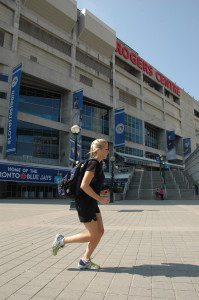
In Toronto, 26 year-old Alexis Brudnicki has been running to work on and off since 2008. Running from her home in Port Credit to her job at the Roger’s Centre as a statistician for the Toronto Blue Jays, is a challenging 21K. The sizable distance means it’s not possible for her to run both directions, so Brudnicki runs to work and takes the Go Train home.
During baseball season, she typically runs every other day when the Jays have home games. Although the most direct distance is about 14K, she prefers a longer, scenic route, incorporating the city’s extensive waterfront trail.
“Some of my colleagues think I’m crazy, but I love it,” she laughs. “I run in the morning, shower at work, and I’m ready for the day.” Describing herself as a recreational runner who enjoys running marathons and half-marathons, run-commuting was part of her training for the recent Barrie Half-Marathon and the Chasing the Unicorn Marathon in Pennsylvania.
Fellow run-commuter Oliver Dennis, a lead actor with Soulpepper Theatre in Toronto’s Distillery District, has been a runner for nine years. The reason he began running? “Vanity, I suppose, which is a horrible reason,” he laughs sheepishly, explaining that before he started running he was getting a little gut he didn’t like. “I just starting gaining weight and I couldn’t control it, like you do when you reach middle age.” Already riding his bike to work, he thought, “how hard could it be to run?” Running has clearly worked for Dennis. His lean physique takes years off the appearance of this agile 51 year old. In fact, research on active commuting suggests it has multiple benefits for our health:
A recent study led by Dr. Christopher Millett at Imperial College London, (PLoS Medicine, 2013), revealed that in India, half of those who travelled to work by private vehicle were overweight, compared with only a quarter of people who traveled to work on foot or by bike. The study revealed similar patterns for rates of high blood pressure and diabetes, and suggests choosing active transportation could reduce some of the risk factors for chronic disease. North American studies, such as those by Dr. Larry Frank at UBC, have yielded similar findings. Examining data from over 10,000 commuters in Atlanta, Frank found that each additional kilometre walked per day is associated with a 4.8 per cent reduction in the likelihood of obesity, while each additional hour spent in a car per day is associated with a 6 per cent increase in the likelihood of obesity (American Journal of Preventive Medicine, 2004). World Health Organization data suggests that, globally, about 3.2 million deaths per year are attributable to insufficient physical activity, and experts worldwide are recognizing a role for active transportation in livening up our sedentary lifestyles.
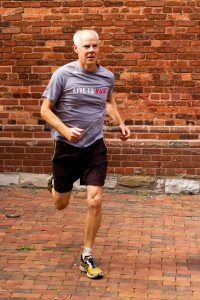
Dennis has reaped many benefits from active commuting. Running to, from, and at work (he runs 3 times a week at lunch) maintains his flexibility and endurance – a big help with the physical demands of long theatrical performances. In order to keep on top of his training while performing, Dennis runs to the show, does the performance, and later runs home. “It’s a split run,” he explains, “but it’s pretty much the only way I can fit a long run in when I’m working as many hours as I’m working.” The distance he runs in his once-a-week run commute varies from six to nine kilometres each way. Typically he runs down the Don Valley, which does have its quirky challenges. A particularly territorial red winged blackbird has a habit of dive-bombing him, once even scratching his head. It was nesting season, so he doesn’t hold it against the protective parental bird.
In Vancouver, 47 year-old Liz Jones has always used a combination of transit, running and cycling to get back and forth to work, especially since the birth of her son. A financial analyst for the City of Vancouver, Jones travels a between six and eight kilometres, depending upon the route, from her home to City Hall at 12th and Cambie Street. A one-car household, her husband needs the vehicle to ferry their son to activities. During the winter of 2010, she got into the habit of avoiding the Winter Olympics crowds on public transportation by combining running to work and cycling home to Kitsilano.
Jones also often selects a longer but more scenic and less trafficked route. Her typical pattern is to cycle in and run home, reversing the pattern on alternate days between Monday and Thursday. Friday is her wildcard day, when she sometimes takes the bus.
Describing herself as a recreational runner, Jones competed in 1500 – 10,000m distances on the track as a teen. With one marathon under her belt, she also now occasionally does 10K road races. On days that she does the run-cycle combination, “I’m usually in a better mood when I get to work,” she says. The bus, by contrast, tends to leave her feeling irritated. Jones sticks to her active commute even when the weather gets ugly. “The weather doesn’t really bother me,” she says.
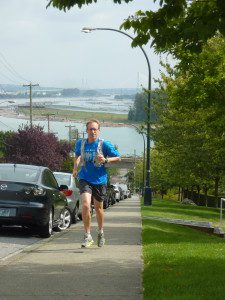
In the Vancouver suburbs, Brian Dickson, a mechanical engineer with Ballard Power, has been running for nearly 20 years. Computer deskwork occupies about 90 per cent of his workday. Married with 7 and 9 year-old daughters, he has a “typical busy household,” says Dickson. “That’s a big part of why I run to work,” referring to the ability to prioritize home time as family time. Describing himself as a competitive runner, Dickson has been running marathons since his 30s. Now 42, he has been getting progressively faster with each of his last six marathons, a trend he attributes in part to his increased running mileage. His idea to run-commute was triggered by a health scare back in 2009, with symptoms including frequent headaches, a symptom that seemed to dissipate when he was regularly running. Before that, Dickson had taken a five-year break from running. When he started up again he decided to challenge himself with marathons. “I was running out of time in the day to get runs in,” explains Dickson. “I’d run at lunch everyday, but I couldn’t really run evenings because of the family, and weekends were pretty booked up, so I was looking for a way to get some good runs in during the week.” His home in Port Coquitlam was about a half-marathon distance away from work, so he decided to give it a try. His route takes him along the Mary Hill By-Pass, through New Westminister, and then an industrial area to Ballard Power’s office in Burnaby.
“I can’t do it every day,” says Dickson, “because first of all I think my legs would fall apart, but I try to get it in two times a week,” he explains. There are about six people at his office that also run-commute. Dickson used to bike to work, but his route had dreadful infrastructure for cyclists. It made him nervous about safety. Advised by a friend that to get faster he needed to run more instead of riding his bike, he made the switch. Run-commuting in the morning, he gets home by carpooling with a neighbour.
“The first few times I did it, it felt like this huge adventure,” says Dickson. Now it’s just routine. Although he feels a bit tired for the first half-hour after he arrives, he refuels at the cafeteria, and has become used to his half-marathon commute, while admitting that his legs feel tired at the end of the day. Run-commuting has helped Dickson train this year for several marathons and the 30-mile Knee Knackering North Shore Trail Run.

Logistics: Planning ahead
There is a common thread to the advice all six run-commuters had for others contemplating this commute style: plan ahead. Each have developed slightly different strategies for managing the task of getting food, towels, toiletries, clothing, work gear – as well as their bodies – back and forth to work. A shower at work is critical. “If I didn’t have a shower that would be pretty nasty,” laughs Dennis. Roch knows a few run-commuters that get by with just wet wipes, but for him, “no shower would mean no run-commuting,” he says.
As for cargo, “that’s the tricky bit,” says Dennis. “I can’t run with [much] stuff on my back, so I have to think ahead,” he explains. On a non-running day he brings clothes, scripts, and lunches for the next day. He also keeps a pair of shoes at work. While running, he carries a tiny backpack for his glasses and perhaps a pair of jeans, but in general, Dennis, like many of the others, finds running with a backpack uncomfortable. Dickson often brings in extra sets of clothes and two extra lunches on a Monday, and keeps a big container of muesli at his desk to stave off the munchies. Gauvin keeps three pairs of shoes, extra shirts and a jacket at work, and carries in a backpack his pants and shirt for that day.
On the days that Jones bikes, she brings clothes for two days to avoid carrying a backpack while running. On running days, she usually purchases lunch near work, and sometimes keeps a stock of almond milkshake or instant oatmeal on hand for quick refuelling.
The day before her run-commute, Brudnicki brings all of her post-run supplies to work, and admits that keeping organized and being prepared is the biggest challenge. Forgetting a towel one day, she had to improvise by buying a beach towel at a pharmacy.
Roch, the die-hard, all-season, daily, bi-directional run-commuter, has settled on a more unusual strategy. After much organizational experimentation, once a week he now drives to work in his car in the evening, when traffic is light, to drop off a large backpack filled with clothing and a week’s worth of lunch food. Roch writes a blog (in French) about his run-commuting experience. “I wouldn’t go back to any other means of transportation,” says Roch. Similar enthusiasm was shared by the others. When asked about the worst part of run-commuting, most were lost for words. “I can’t think of a bad thing,” said Dennis. Brudnicki suggested the worst thing was also the best: once you’re committed, “you’re forced to get it done.
Thinking of giving this mode of transportation a try? Here are some tips from the run-commuting gurus:
- • Start slowly, increasing mileage gradually, just as you would any other training program. Start with one direction, once a week.
- • Choose a route you like – not necessarily the shortest.
- • Prepare for the weather and don’t let it stop you.
- • Plan ahead. Take supplies to work ahead of time so you can avoid carrying unnecessary weight on your back.
- • Give yourself extra time for unforeseen delays.
- • Carry bus or taxi fare in case you need to abort your mission.
- • Enjoy the time to decompress, relax, and opt out of traffic jams.
- • If you’re one of the 1.1 million Canadians that work from home, you can use that saved commuting time to run from point A… to A.
US run-commuters have started their own Facebook group, where you may find some other useful tips and shared experiences.
